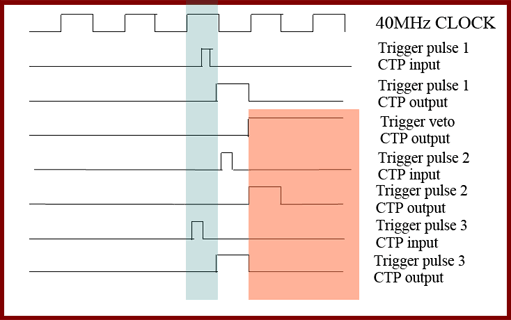
ATLAS e-News
23 February 2011
The TRT track trigger
27 July 2009

Timing with LHC bunch crossing rates: trigger pulses 1 and 3 make it into the 25 nano-second window, but trigger pulse 2 arrives outside that window and is rejected
The designers of the Transition Radiation Tracker electronics used foresight, planning chips that could not only receive trigger signals and read out data during normal running, but also be made to send out trigger signals of their own. This functionality was only realised in the fall of last year, when the shutdown meant that ATLAS would not be seeing beam for a while. With this refinement to the trigger system, ATLAS can take a higher rate of cosmic rays that run through the Inner Detector. And a few teams are even using this data for physics.
The muon system was ATLAS’s usual cosmic trigger – after all, few particles apart from muons can make it through the 100 metres of rock above the cavern, and the muon system envelops all of ATLAS. However, the Inner Detector has a radius of one metre, and a length of seven metres, according to Andreas Korn, while the muon system and calorimeters extend that radius another ten metres. It is very easy for a cosmic ray to miss the Inner Detector entirely and still be recorded in the muon spectrometer.
Previously, all the data was taken, sorting out the cosmic tracks that had hit only the muon system from those that had gone all the way through the centre of the ATLAS detector later on. Using the TRT’s “fast-OR” trigger, ATLAS can increase the proportion of recorded tracks that run through the TRT, and the Inner Detector generally, while still leaving the muon spectrometer with plenty of cosmic data.
Ordinarily, a triggering sub-detector will send a signal to the Central Trigger Processor (CTP). Then, “the CTP sends it to all other sub-detectors and says ‘readout’,” according to Peter Wagner, DAQ expert for the TRT. In the TRT, this signal comes into the Trigger Timing and Control (TTC) electronics and is passed on to the Front End electronics, which then spit their data into the readout chain.
When the fast-or trigger is engaged, it can send a message from the Front End electronics to the TTC system of the TRT, which forwards a trigger signal to the CTP so that all other detectors read out their data. “And if everything is very well timed in, that signal gets sent to the CTP, always at the same time relative to when a track crossed the TRT detector,” Peter explains. “Then, when the CTP tells the sub-detectors to read out, all the sub-detectors should actually see this track in the readout.”
Since October, when ATLAS recorded its first track based on the TRT trigger, Peter has been hard at work optimising the timing of the system. Now, the muon Resistive Plate Chambers (RPCs) group has been using the reliability of the TRT trigger to study RPC trigger timing. The higher track rate in the Inner Detector, within a narrow time window, has also been used by the Pixel detector, Semiconductor Tracker, Beam Conditions Monitor, and Liquid Argon calorimeter teams to study their systems.
While the cosmic data recorded by the TRT trigger is useful in refining timing and alignment in other ATLAS sub-detectors, it is also used for physics. Andreas’s team is seeking information about the ratio of positive to negative muons running through ATLAS.
These muons are products of cosmic rays striking the upper atmosphere. The original rays may be protons or small nuclei from helium to iron, and they often collide with nitrogen or oxygen molecules, which make up the bulk of Earth’s air. “When these hit the atoms at the top of the atmosphere, they produce more particles,” says Andreas. “One type of the particles that are produced are light mesons, particularly pions or kaons.”
The charged pions and kaons decay to muons of the same charge. Kaons decay more quickly than pions, so they are less likely to smash into more nitrogen and oxygen molecules before turning into a muon, which can pass through the atmosphere unhindered. Pions, in contrast, are likely to strike more atmospheric molecules, resulting in lower-energy muons when they do finally decay. While kaons favour positive charge more often than pions, the dominance of protons over anti-protons in the atmosphere is the major influence in the muon charge ratio observed underground.
“The answer is essentially 1.3,” says Andreas, in favor of positive charge. So far, ATLAS’s results agree with the world average for this type of measurement. But by measuring the charge ratio – as well as the spectrum of energies among arriving particles, he hopes that ATLAS’s data can help inform those working on neutrino experiments.
When each kaon or pion decays to a muon, a neutrino is also produced. Knowing the energy spectrum for the measured muons, neutrino physicists can predict the rate of neutrinos that they would record if the particles weren’t so difficult to catch.
Not only is the fast-OR trigger of the TRT allowing other teams to hone timing and alignment, it is also making it possible to use ATLAS for physics even before we have seen the first collisions.

Katie McAlpineATLAS e-News |